Loyal customers are ideal for all businesses. Thanks to effective customer loyalty marketing strategies, they are more likely to buy more than one product, write positive reviews, recommend us to others, and be willing to pay a higher price for our products.
But how do we identify our loyal customers, and what can we do to keep more of them loyal? Various market research methodologies attempt to understand essential factors relating to customer behavior and augment customer loyalty through initiatives like rewards programs, discounts, and complimentary items.
That’s where customer loyalty research comes in.
Loyalty research involves collecting data and feedback about our customers’ attitudes, perceptions, and behaviors toward our brand. This information can help us identify what loyalty looks like for our customers and how we can increase it.
What is Customer Loyalty?
Customer loyalty is a deeply held commitment to re-buy or re-patronize a preferred product or service consistently in the future. This commitment results in repetitive same-brand purchasing behavior. It is about both attitude and behavior.
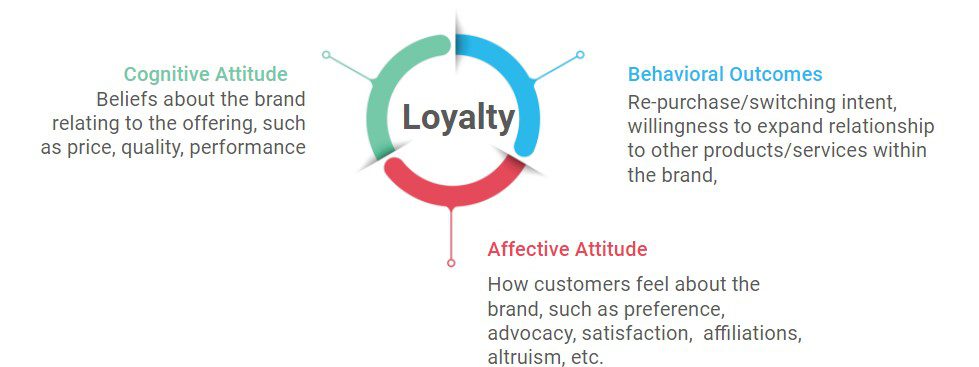
We can view loyalty in terms of the brand. People are often loyal to a brand because they associate it with a positive experience, such as excellent customer service or consistently high product quality. This is where brand loyalty comes into play, as it fosters stronger connections with consumers and encourages repeat business.
It’s about many positive interactions that build trust. This doesn’t mean every interaction must be flawless. Although customer loyalty can handle a few negatives, it provides a strong enough relationship with the brand to overcome a few bumps.
Customers won’t necessarily lose their loyalty to a brand if they have an unpleasant experience. It’s all about how the business deals with the issue.
Customer loyalty is powerful because it involves trust. Building strong customer relationships through consistent and meaningful interactions is critical to fostering this trust.
Share of Wallet
When measuring loyalty, it’s essential to determine if it means anything or if it will benefit the business. When considering financial performance, customer loyalty is about the “share of wallet.” While market share is an important measure of success, the share of wallet is a deeper metric that better shows how companies can become exponentially more profitable without exponential growth in the number of customers.
How much money will your customer spend regularly with you? Implementing a well-structured customer loyalty strategy can significantly increase the share of wallet by encouraging repeat purchases and higher spending.
What is Share of Wallet (SOW)?
The customers' share of wallet (SOW) is the average amount they devote to a brand over competing brands in the same product group.
In other words, the share of wallet is the percentage of a consumer's money spent on one particular brand in relation to that spent on competing brands.
Inertia
Customers may continually frequent certain businesses, such as supermarkets, but this behavior may not be loyal. They may shop at the same supermarket every week but will readily switch to a different one if they get a better deal.
Consider mobile phone carriers, insurance, or energy bills. They will often have a significant share of your wallet for many years. This is not necessarily because of loyalty. It is usually because of either necessity (a contract that you have signed for at least a year) or inertia (“you don’t want to shop around”).
Market research has shown that switching costs are not as substantial a technique for maintaining the customer base as maintaining customer loyalty. Implementing a customer loyalty program can effectively counteract inertia by providing incentives for repeat business and fostering a deeper emotional connection with the brand.
Customer loyalty goes beyond whether customers spend money with you. It’s also about emotion and identity.
Loyalty and Identity
Customer loyalty varies widely across different industry segments.
Identity products are those that are highly visible and which support a customer's self-image or public persona.
Selling and building customer loyalty with an identity product is quite different from a product like an insurance policy.
Your car is a prime example of an identity product. The jewelry and clothing you wear, as well as the mobile phone you carry every day, are identity brands.
So, with an identity product, it's not about the amount you spend—your loyalty exists because of your relationship with the brand and its role in helping you define and communicate your identity. This relationship is deeply tied to the brand experience, which is crucial in fostering long-term customer loyalty.
Understanding Customer Loyalty
Customer loyalty is a multifaceted concept that can be understood through various types of loyal customers. By recognizing and catering to these different types, businesses can develop effective strategies to foster loyalty and drive growth. Understanding customer loyalty involves more than just knowing who your loyal customers are; it’s about understanding why they are faithful and how to keep them engaged.
Types of Loyal Customers
Happy Customer
Happy customers have had a consistently positive experience with a brand and are likely to continue purchasing from it. They are satisfied with the product or service and have no significant complaints.
However, they can be easily swayed by competitors who offer better deals or discounts. These customers are crucial for maintaining customer loyalty, but businesses must continuously engage them to prevent them from drifting away.
Price-loyal
Price-loyal customers prioritize low prices above all else. They will continue purchasing from a brand if it offers the best price but quickly switch to a competitor if they find a better deal. These customers are not necessarily loyal to the brand but to the price point. To retain price-loyal customers, businesses can implement price-matching guarantees and offer regular discounts or promotions.
Convenience-loyal
Convenience-loyal customers value ease and convenience above all else. They will continue to purchase from a brand that makes it easy for them to do so, whether through a user-friendly website, convenient store locations, or a streamlined checkout process.
These customers are loyal to the brand’s convenience rather than the product or service itself. Enhancing the customer experience by making interactions as seamless as possible can help maintain customer loyalty among this group.
By understanding these different types of loyal customers, businesses can develop targeted strategies to foster loyalty and drive growth. For example, happy customers may respond well to loyalty programs that offer rewards and exclusive benefits, while price-loyal customers may be more responsive to price-matching guarantees and discounts.
Convenience-loyal customers, on the other hand, may appreciate streamlined checkout processes and convenient store locations.
By catering to the unique needs and preferences of each type of loyal customer, businesses can build strong relationships and drive long-term growth. This approach helps maintain customer loyalty and enhances the overall customer experience, leading to satisfied customers who are more likely to become brand advocates.
Why is Customer Loyalty Important?
A loyal customer is…
- 5x more likely to repurchase
- 5x more likely to forgive
- 4x more likely to refer
- 7x more likely to try a new offering
These behaviors are positive and helpful to a business. They reflect both a positive attitude towards the company and positive behavior.
Loyal customers are a driving force for business growth and are valuable customers.
Traditionally, companies have used customer satisfaction surveys or net promoter scores to identify loyal customers and measure customer loyalty. Unfortunately, these measures focus primarily on attitudinal measures and neglect behavioral elements.
Customer satisfaction does not guarantee loyalty.
“Between 65% and 85% of customers who defect said they were ‘satisfied' or ‘very satisfied' with their former supplier.”
-Frederick F. Reichheld, “Loyalty and the Renaissance of Marketing”
Loyalty is essential for many reasons. Not least, it takes much less effort to keep a customer than it does to gain a new one. If you don't have to, why would you spend more money to sell to an existing customer?
According to Paul Farris, author of Marketing Metrics, a repeat customer has a 60-70% chance of converting.
New customers can be challenging to convert as they know little about your business. It is important to inform them of your business and brand and a detailed marketing strategy to drive them down the funnel.
Customers who have already purchased from you will be more familiar with your business, and persuading them to buy again will be easier. The more repeat buyers you have, the less money you spend on conversion strategies like abandoned cart offers.
There are other reasons, too. Loyal customers will continue returning to you, spending more time with you, and telling their friends about your brand.
Mapping the Loyalty Landscape
Several elements contribute to a company's loyalty landscape. Any loyalty research project or measurement program must assess the relative contribution of each.
Perceived Quality
What are the customers' impressions regarding the company's brands and how they are delivered? Perceived quality is instrumental in effective customer acquisition strategies.
Perceived Value
How do customers feel about the price and value-for-money of the company's brands? We may enhance the perceived value through the employment of loyalty programs.
Switching Costs
How do customers perceive the switching costs if they decide to leave?
Dialog
Is the company reaching out and communicating with its customers frequently?
Customer Experience
How do customers experience the brand across all touchpoints? The customer experience is important for cementing the brand's relationship with new customers on an emotional level.
Service Recovery
How do customers feel when the company makes a mistake? How do they feel about the way the problem was handled?
Customer Satisfaction
How satisfied are customers with the company's products?
The Asymmetric Loyalty Matrix
This matrix identifies and allows the segmentation of customers across critical loyalty categories to assess attitudinal and behavioral outcomes.
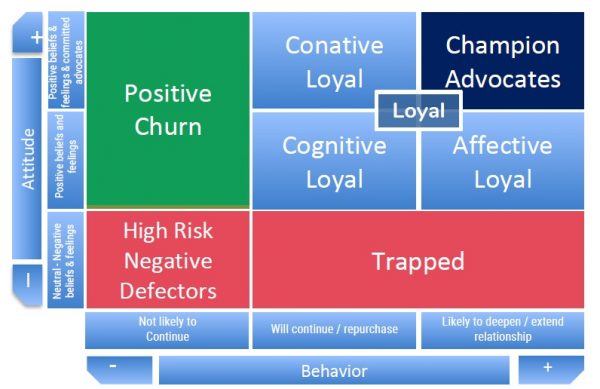
Positive Customer Churn
Every business experiences churn. Customers will discontinue using a company's products or services for several reasons.
The goal is to minimize churn, assess retention opportunities, and ensure that those who leave do not do so with a negative opinion of the brand.
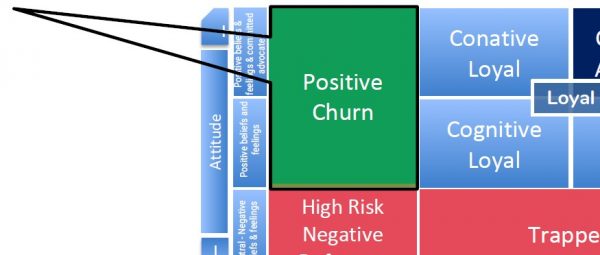
High-Risk Negative Defectors
Customers who leave and have a negative attitude toward the brand are a threat, as they may become brand assailants who actively discourage others from using the brand.
The goal is to assess retention opportunities and to eradicate assailant motives.
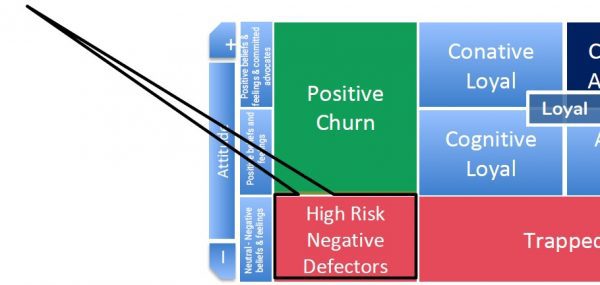
Trapped
Trapped customers have a negative attitude towards the brand but must continue or expand their relationship. When presented with the opportunity, these customers will defect and may become brand assailants.
The goal is to ease the negative attitudes of these customers and improve their customer experience.
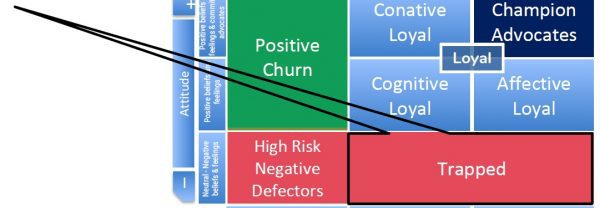
Loyal Customers
Customers who develop a positive attitude toward a brand pass through four stages of customer loyalty development, each requiring different management strategies.
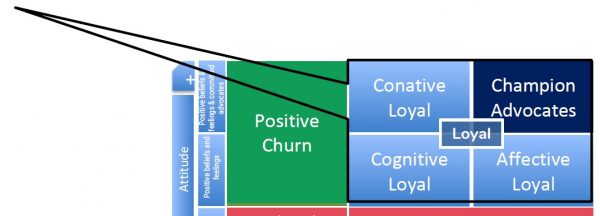
Customers who develop a positive attitude toward a brand pass through four stages of customer loyalty development, each requiring different management strategies.
Cognitive Loyal is the first stage of loyalty and is broadly based on brand perceptions of superiority rather than deep experience.
Affective loyalty is the second stage of customer loyalty. In this stage, customers develop a genuine liking and positive attitude toward the brand, based on repeated satisfying experiences.
Conative loyalty is the third stage of loyalty. At this stage, customers develop high involvement and intense connections with the brand, becoming brand advocates.
Champion Advocates are customers in the fourth stage of loyalty. Here, they become evangelists and will work tirelessly to overcome potential obstacles that might prevent them from using their preferred brand.
Loyalty Research
Customer loyalty research projects are an essential type of market research. They begin with a strategy session to align the research agency with the company's interests, concerns, and desired outcomes.
These customer loyalty research projects begin with measurement, principally through surveys. Once the survey is completed, the data is analyzed, and the report is prepared.
The customer survey is designed, coded for online participation, and launched. Loyalty surveys target customer behaviors and attitudes within the universe of current customers.
These surveys are typically conducted online, but they can also be conducted by telephone. History has shown that today, most customers prefer to take part in online surveys. We tailored the sample size of the survey to the specific needs of the company, but it is at least n=200.
Once the results of the customer loyalty research survey are collected and collated, the analysis begins. First, we segment the customers according to their loyalty type. Subsequently, they are profiled and evaluated using detailed diagnostic analysis.
Once the analysis is completed, the final report is prepared, and a presentation is made to the company.
Profiling Segments
Once the loyalty segments have been sized, we develop a detailed profile to facilitate strategic prioritization. We should fully represent each customer segment in the survey, so quotas may be necessary to ensure proper representation.
We must customize the profile to a company's particular business and brands.
Typical profiling variables for customer loyalty research include customer value, the product used, age of client relationships, complaint profile, servicing costs, frequency of contact, and participation in a rewards program.

Activation
We present results in a cross-functional workshop, which prioritizes loyalty activation insights and is ideally attended by representatives and stakeholders from each key customer touchpoint.
Output from the workshop is summarized and documented for the company in a permanent report replete with raw data, analyzed data, charts, and slides. We develop a strategic impact matrix for each loyalty segment, mapping the impact on loyalty and relative performance for each loyalty driver.
Once segments are prioritized for the company, improvement areas can be easily mapped and activated.

Six Impacts of Increased Customer Loyalty
- Loyal customers buy more frequently and are often willing to pay more.
- These customers do not stray, and their lifetime value increases.
- Loyal customers actively refer others to the company.
- They increase employee loyalty.
- Loyal customers provide valid and constructive feedback.
- A loyal customer is more forgiving.
What is Customer Lifetime Value?
Customer lifetime value (CLV) refers to the total value of a customer's business over the entire relationship duration. This is an important metric because it costs less to keep existing customers than to gain new customers.
Increasing the value of existing customers can be a great path to growth. Understanding the CLV can help businesses create strategies to attract or keep new customers while maintaining profit margins.
CLV differs from the net promoter score (NPS), which attempts to measure customer loyalty, and CSAT, another type of market research that measures customer satisfaction. CLV is tangible and linked to revenue rather than a promise of loyalty or satisfaction.
Customer Lifetime Value (CLV) is an essential metric businesses use to measure the value of long-term relationships. CLV is directly tied to the company's bottom line, making it especially useful for customer success teams and marketers. It allows them to quantify an organization's customer experience (CX).
Certain people will be more loyal to your company than others. You might find them loyal initially but then lose that loyalty. Or they may be neutral and build loyalty. It is possible to notice that their loyalty manifests in their buying patterns but does not translate into related behaviors such as referrals, positive reviews, or recommendations.
Measuring customer loyalty over time is important because of its complexity and power. We can do this using a variety of metrics that capture customer journeys via business data and customer feedback.
This will allow you to understand your customer base and the loyalty behaviors that drive them. It also lets you determine how your company can help customers stay loyal. This is true regardless of whether you are a large or small corporation. Knowledge and insight are the keys to customer loyalty.
Loyalty Programs
Retailers and other companies sponsor loyalty programs that offer discounts, rewards, and other incentives to keep and attract new business.
These loyalty programs should encourage repeat business and reward loyalty to the store or brand. The rewards are usually higher for customers who patronize the merchant more often and spend more.
Loyalty programs serve two primary functions. They reward customers who return their repeat business and provide the issuing company with a wealth of data and consumer information. Companies can still evaluate anonymous purchases, but loyalty programs provide additional information about the products and the effectiveness of specific incentives.
Conclusion
Customer loyalty research is a valuable method of identifying not only a satisfied customer but also one likely to exhibit positive attitudinal and behavioral characteristics. While a satisfied customer is a positive asset for a company, a loyal customer is more valuable by an order of magnitude.
Companies of all sizes can use loyalty research. This type of research can help determine the goods and services your customers value most. Focusing on the customer is an asymmetric strategy that can help you win in the marketplace against competitors who are less customer-centric.
Frequently Asked Questions About Loyalty Research
What is loyalty research?
Loyalty research involves gathering and analyzing data about your customers' behaviors, preferences, and satisfaction levels. This helps businesses understand what drives customer loyalty and how to improve it.
How can loyalty research benefit my business?
Loyalty research can provide insights into customer satisfaction, identify areas for improvement, and help develop strategies to increase customer retention. This can lead to higher customer lifetime value, more repeat business, and improved brand reputation.
What methods are used in loyalty research?
Common methods include surveys, focus groups, customer feedback, and data analysis of purchase behaviors. Advanced techniques might involve sentiment analysis, net promoter scores (NPS), and customer journey mapping.
How often should I conduct loyalty research?
The frequency can vary based on your business needs, but it's generally recommended to conduct loyalty research annually or biannually. Regular monitoring helps track changes over time and adapt strategies accordingly.
What key metrics should I focus on in loyalty research?
Important metrics include customer satisfaction scores, NPS, customer retention, churn, and repeat purchase rates. These metrics help gauge the effectiveness of your loyalty programs and identify areas for improvement.
How do I implement changes based on loyalty research findings?
Start by analyzing the data to identify key areas of improvement. Develop action plans that address these areas, such as enhancing customer service, improving product quality, or launching targeted marketing campaigns. Monitor the impact of these changes and adjust as needed.
Can small businesses benefit from loyalty research?
Absolutely. Loyalty research is valuable for businesses of all sizes. For small businesses, understanding what keeps customers returning can be crucial for growth and building a loyal customer base.
How does loyalty research integrate with other marketing strategies?
Loyalty research complements other marketing strategies by better understanding customer needs and preferences. This information can be used to tailor marketing messages, develop personalized offers, and enhance overall customer experience.
What are some common challenges in conducting loyalty research?
Challenges include collecting accurate data, ensuring a representative sample, and interpreting the data correctly. It's also important to act on the findings promptly to make meaningful improvements.
How can Asymmetric Marketing help with loyalty research?
Asymmetric Marketing offers comprehensive loyalty research services, including survey design, data collection, and analysis. Our team can help you interpret the findings and develop actionable strategies to boost customer loyalty and drive business growth.

Ready to Leverage Loyalty Research to Boost Your Business?
Unlocking the power of customer loyalty can significantly improve your business’s growth and sustainability. If you’re ready to dive deeper into how loyalty research can enhance your strategies and retention efforts, we’re here to help.
Discover More
Want to learn how loyalty research can directly benefit your business? Click here to schedule a free consultation, and let’s explore personalized strategies to strengthen your customer base.
Explore Our Insights
Check out our latest articles on customer loyalty, marketing strategies, and business growth. Read more insights here to stay ahead of the competition.
Get Started Today
Don’t miss out on the opportunity to maximize your customer retention. Contact us to start building a loyalty-driven business strategy that leads to long-term success.
About the author
Mark A. Hope is the co-founder and Partner at Asymmetric Marketing, an innovative agency dedicated to creating high-performance sales and marketing systems, campaigns, processes, and strategies tailored for small businesses. With extensive experience spanning various industries, Asymmetric Marketing excels in delivering customized solutions that drive growth and success. If you’re looking to implement the strategies discussed in this article or need expert guidance on enhancing your marketing efforts, Mark is here to help. Contact him at 608-410-4450 or via email at mark.hope@asymmetric.pro.

